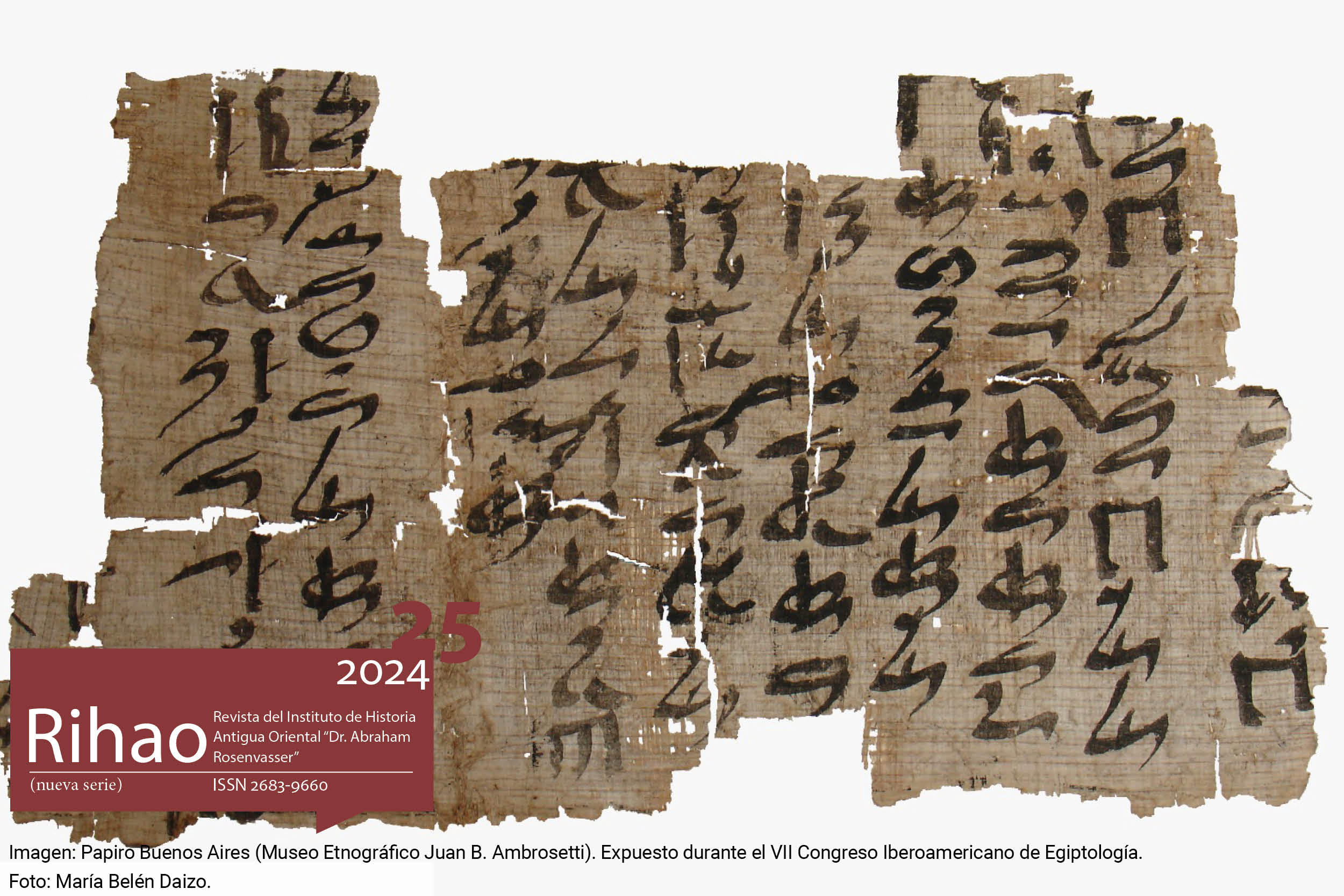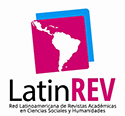Origen y materialidad de la escritura en Israel y el antiguo Egipto. Filología y arqueología en diálogo
Resumen
El contexto material donde vemos emerger los jeroglíficos egipcios y el protosinaítico alfabético que se inspira en ellos, ambos en la tierra de Egipto, se pone en relación con la materialidad fonética orgánica que tienen en común redactores y receptores del texto, como posible vía de acceso para una construcción identitaria. El contacto permanente con elementos divinizantes en las minas del Sinaí, lugar de origen para el protosinaítico, coincide con el entorno vinculado a la resurrección y vida en el Más Allá de la tumba material donde encontramos la emergencia de los jeroglíficos en el valle del Nilo. A pesar de tratarse de una lengua alfabética lineal, vemos que el corpus delimitado y autónomo del hebreo bíblico mantiene la misma versatilidad y poder creativo de los jeroglíficos. Estas convergencias son ilustradas con tres ejemplos para concluir sugiriendo la posibilidad de estudiar los orígenes e identidad de Israel tomando en consideración la creación de la escritura.Descargas
Citas
Agmon, N. (2010). Materials and Language: Pre-Semitic Root Structure Change Concomitant with Transition to Agriculture, en: Brill’s Annual of Afroasiatic Languages and Linguistics 2: 23-79. En línea: https://doi.org/10.1163/187666310X12688137960669. [Consultado: 15-2-2023].
Agmon, N. y Bloch, Y. (2013). Statistics of Language Morphology Change: From Biconsonantal Hunters to Triconsonantal Farmers, en: PLoS ONE 8 (12): e83780. En línea: https://doi.org/10.1371/journal.pone.0083780. [Consultado: 15-2-2023].
Angenot, V. (2018). Rébus, calembours et images subliminales dans l’iconographie égyptienne, en: Brisset, C.-A., Dumora, F. y Simon-Oikawa, M. (eds.), Rébus d’ici et d’ailleurs: écriture, image, signe. París: Maisonneuve & Larose, 85-103.
Aufrère, S. H. (1997). L’univers minéral dans la pensé égyptienne: essai de synthèse et perspectives, en: Archéo-Nil 7: 113-144.
Bohas, G. (1997). Matrices, étymons, racines. Eléments d’une théorie lexicologique du vocabulaire árabe (Orbis Supplementa 8). Lovaina: Peeters.
Campagno, M. (2007). El origen de los primeros Estados: la “revolución urbana” en América precolombina (Colección Ciencia Joven 24). Buenos Aires: Eudeba.
Cervelló Autuori, J. (2005). Los orígenes de la escritura en Egipto: entre el registro arqueológico y los planteamientos historiográficos, en: Carrasco Serrano, G. y Oliva Mompeán, J. C. (coords.), Escrituras y lenguas del Mediterráneo en la antigüedad (Humanidades 82). La Mancha: Universidad de Castilla, 191-240.
Cervelló Autuori, J. (2020 [2015]). Escrituras, lengua y cultura en el antiguo Egipto, 2ª ed. (El espejo y la lámpara 11). Barcelona: Servei de Publicacions de la Universitat Autònoma de Barcelona.
Davies, B. G. (1999). Who’s Who at Deir el-Medina. A Prosopographic Study of the Royal Workmen’s Community. Leiden: Nederlands Instituut voor het Nabije Oosten.
De Benedetti, P. (2011). L’alfabeto ebraico. Brescia: Morcelliana.
Gardiner, A. H. y Peet, T. E. (1917). The Inscriptions of Sinai, vol. 1 (Egypt Exploration Society Excavation Memoir 36). Londres: Egypt Exploration Society.
Goldwasser, O. (1995). From Icon to Metaphor. Studies in the Semiotics of the Hieroglyphs. Friburgo / Gotinga: University Press / Vandenhoeck & Ruprecht.
Goldwasser, O. (2006). Canaanites Reading Hieroglyphs. Horus is Hathor? - The Invention of the Alphabet in Sinai, en: Ägypten und Levante 16: 121-160.
Goldwasser, O. (2011). The Advantage of Cultural Periphery. The Invention of the Alphabet in Sinai (circa 1840 B.C.E.), en: Sela-Sheffy, R. y Toury, G. (eds.), Culture Contacts and the Making of Cultures. Papers in Homage to Itamar Even-Zohar. Tel Aviv: Unit of Culture Research / Tel Aviv University, 255-321.
Gracia Zamacona, C. (2017 [2011]). Manual de Egipcio Medio, 2ª ed. Oxford: Archaeopress.
Hikade, T. (2007). Crossing the Frontier into the Desert: Egyptian Expeditions to the Sinai Peninsula, en: Ancient West & East 6: 1-22.
Invernizzi, L. (2016). La mano, il tamburello, la danza delle donne. La “scenatipo” del canto di vittoria, en: Crimella, M., Pagazzi, G. y Romanello, S. (eds.), Extra ironiam nulla salus. Studi in onore di Roberto Vignolo in occasione del suo LXX compleanno (Biblica 8). Milán: Glossa, 73-99.
Kaplan, A. (1985). Meditation and Kabbalah. San Francisco: Weiser.
Klein, E. (1987). A Comprehensive Etymological Dictionary of the Hebrew Language for Readers of English. Jerusalén / Tel Aviv: Carta Jerusalem / The University of Haifa.
Liverani, M. (2005 [2003]). Más allá de la Biblia. Historia antigua de Israel. Traducción de Teófilo de Lozoya. Barcelona: Crítica.
Mandell, A. (2022). More than the Sum of Their Parts, en: Keimer. K. y Pierce. G. (eds.), The Ancient Israelite World. Londres / Nueva York: Routedge / Taylor and Francis Group, 348-362.
Menéndez Gómez, G. (2008). Extranjeros en Deir El-Medina durante las dinastías XVIII y XIX: integración e inserción social. Tesis doctoral. Madrid: Universidad Autónoma de Madrid, Departamento de Prehistoria y Arqueología. En línea: http://hdl.handle.net/10486/3155. [Consultado: 22-11-2022].
Menéndez Gómez, G. (2009). Población extranjera en Deir el-Medina: Documentos y problemas de identificación (D. XVIII-XIX), en: Aula Orientalis 27: 153-170.
Niccacci, A. (2009). Esodo 15. Esame letterario, composizione, interpretazione, en: Liber Annuus 59: 9-26.
Niccacci, A. (2020 [1986]). Sintassi del verbo ebraico nella prosa biblica classica, 2ª ed. Milán: Terra Santa.
Salem, L. (2014). Literatura, memoria y política: La construcción del pasado en el Reino Medio egipcio, en: Veleia 31: 183-198.
Salvador, A. N. (2020). La sintaxis poética de Alviero Niccacci en los textos bíblicos hebreos, en: LynX. Panorámica de Estudios Lingüísticos 19: 146-178.
Salvador, A. N. (2021). El ritmo del nuevo orden intelectual inaugurado en Egipto en la sintaxis del hebreo bíblico, en: LynX. Panorámica de Estudios Lingüísticos 20: 201-235.
Salvador, A. N. (2022a). La posibilidad de habitar un texto. La materialidad de la escritura en Israel y el Antiguo Egipto, en: Helmántica. Revista de filología clásica y hebrea 73: 239-270.
Salvador, A. N. (2023a). Las sucesivas metamorfosis del protagonista como tema literario en La historia bíblica de José de la Biblia hebrea y el cuento neoegipcio de Los dos hermanos, en: Revista de Filología y Lingüística de la Universidad de Costa Rica 49 (2): e54416. En línea: https://doi.org/10.15517/rfl.v49i2.54416. [Consultado: 5-9-2023].
Salvador, A. N. (2023b). De la letra en la tumba a la frase en el texto. La recepción en el mundo moderno del doble origen de la escritura en el antiguo Egipto, en: Alderete, M., Jakubowicz, F. y Rodríguez, I. (comps.), I jornadas sobre usos y recepción de la historia antigua: “El antiguo Egipto como fantasía moderna: a cien años del descubrimiento de la tumba de Tutankhamón”. Buenos Aires: Editorial de la Facultad de Filosofía y Letras, Universidad de Buenos Aires. En línea: http://eventosacademicos.filo.uba.ar/index.php/JURHA/IJURHA/paper/viewFile/6866/4118. [Consultado: 1-11-2024].
Scholem, G. (1995 [1946]). Major Trends in Jewish Mysticism, 2ª ed. Nueva York: Schochken.
Sibony, J. (2013). De l’analysibilité des racines de l’hébreu biblique. Tesis de doctorado. Lyon: École normale supérieure de Lyon. En línea: https://theses.hal.science/tel-00935550. [Consultado: 22-11-2022].
Ska, J.-L. (2001). Introducción a la lectura del Pentateuco. Claves para la interpretación de los cinco primeros libros de la Biblia. Traducción de Francisco Gordón. Estella (Navarra): Verbo Divino.
Trebolle Barrera, J. C. (1993). La Biblia judía y la Biblia cristiana. Introducción a la historia de la Biblia, 2ª ed. Madrid: Trotta.
Vernus, P. (2005). Dictionnaire amoureux de l’Égypte pharaonique. París: Plon.
Vernus, P. (2016). De l’image au signe d’écriture, du signe d’écriture à l’image, de l’image au signe d’écriture: la ronde sémiotique de la civilisation pharaonique, en: Actes Sémiotiques 119: 1-19.
Vernus, P. (2018). Le rébus dans l’écriture hiéroglyphique de l’Égypte pharaonique: un procédé cognitif, en: Brisset, C.-A., Dumora, F. y Simon-Oikawa, M. (eds.), Rébus d’ici et d’ailleurs: écriture, image, signe. París: Maisonneuve & Larose, 45-66.
Vernus, P. (2020). Écriture, langue et images: la naissance des hiéroglyphes, en: Claroscuro 19: 1-23.
Vita Barra, J. P. (2005). Los primeros sistemas alfabéticos de escritura, en: Carrasco Serrano, G. y Oliva Mompeán, J. C. (coords.), Escrituras y lenguas del Mediterráneo en la antigüedad (Humanidades 82). La Mancha: Universidad de Castilla, 33-79.
Vives Cuesta, A. y Nicolás Alonso, S. (2020). Parámetros de clasificación zoológica comparados: la familia Anatidae en egipcio y sumerio, en: Trabajos de Egiptología 11: 369-390.
Watson, W. (2011). Alcuni brani dellʼAntico Testamento e testi dal Vicino Oriente antico, en: Gregor, G. (ed.), Ἐν πάσῃ γραμματικῇ καὶ σοφίᾳ: Saggi di linguistica ebraica in onore di Alviero Niccacci, ofm. Jerusalén / Milán: Terra Santa, 371-379.
Derechos de autor 2024 Adriana Noemí Salvador

Esta obra está bajo licencia internacional Creative Commons Reconocimiento-NoComercial 4.0.





.jpg)







